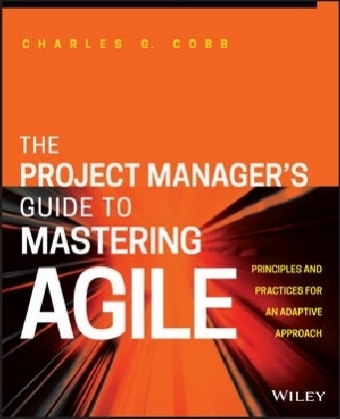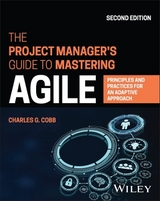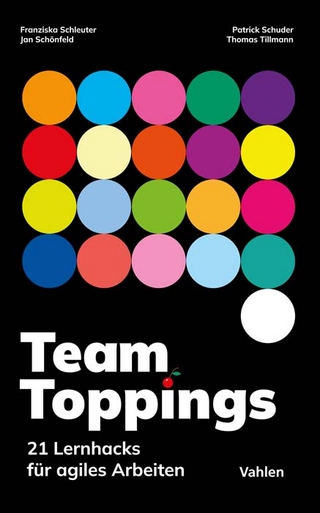
The Project Manager′s Guide to Mastering Agile – Principles and Practices for an Adaptive Approach
John Wiley & Sons Inc (Verlag)
978-1-118-99104-6 (ISBN)
- Titel erscheint in neuer Auflage
- Artikel merken
Streamline project workflow with expert agile implementation The Project Management Profession is beginning to go through rapid and profound transformation due to the widespread adoption of agile methodologies. Those changes are likely to dramatically change the role of project managers in many environments as we have known them and raise the bar for the entire project management profession; however, we are in the early stages of that transformation and there is a lot of confusion about the impact it has on project managers: * There are many stereotypes and misconceptions that exist about both Agile and traditional plan-driven project management, * Agile and traditional project management principles and practices are treated as separate and independent domains of knowledge with little or no integration between the two and sometimes seen as in conflict with each other * Agile and "Waterfall" are thought of as two binary, mutually-exclusive choices and companies sometimes try to force-fit their business and projects to one of those extremes when the right solution is to fit the approach to the project It s no wonder that many Project Managers might be confused by all of this!
This book will help project managers unravel a lot of the confusion that exists; develop a totally new perspective to see Agile and traditional plan-driven project management principles and practices in a new light as complementary to each other rather than competitive; and learn to develop an adaptive approach to blend those principles and practices together in the right proportions to fit any situation. There are many books on Agile and many books on traditional project management but what s very unique about this book is that it takes an objective approach to help you understand the strengths and weaknesses of both of those areas to see how they can work synergistically to improve project outcomes in any project. The book includes discussion topics, real world case studies, and sample enterprise-level agile frameworks that facilitate hands-on learning as well as an in-depth discussion of the principles behind both Agile and traditional plan-driven project management practices to provide a more thorough level of understanding.
CHARLES G. COBB is President of Breakthrough Solutions, Inc., a consulting company that specializes in helping companies develop more effective enterprise-level Agile implementations. He is passionate about helping to close the gap between the Agile and traditional project management communities. He has published two prior books on Agile Project Management, written over 50 articles, and has been a guest speaker at numerous PMI(R) and Agile events. He is an Adjunct Professor at Boston University where he teaches a graduate-level Agile Project Management course and he is a practicing project/program manager with numerous project management and agile certifications over 30 years of experience.
PREFACE xiii ACKNOWLEDGMENTS xix 1 Introduction to Agile Project Management 1 The Chasm in Project Management Philosophies 2 The Evolution of Agile and Waterfall 3 Definition of waterfall 4 Definition of agile 4 Comparison of plan-driven and adaptive approaches 5 The Evolution of the Project Management Profession 7 The early history of project management 7 Transformation of the project management profession 8 What s driving this change, and why now? 9 Agile Project Management Benefits 11 Summary of Key Points 13 Discussion Topics 14 Part 1 Fundamentals of Agile 2 Agile History and the Agile Manifesto 17 Agile Early History 17 Dr. Winston Royce and the Waterfall model (1970) 18 Early iterative and incremental development methods (early 1970s) 19 Further evolution of iterative and incremental development (mid- to late 1970s) 20 Early agile development methods (1980s and 1990s) 20 Agile Manifesto (2001) 21 Agile Manifesto values 22 Agile Manifesto principles 24 Summary of Key Points 30 Discussion Topics 31 3 Scrum Overview 33 Scrum Roles 34 Product owner role 35 Scrum Master role 36 Team role 38 Scrum framework 39 Sprint planning 41 Daily standup 42 Sprint review 42 Sprint retrospective 43 General Scrum/Agile Principles 44 Variability and uncertainty 44 Prediction and adaptation 45 Validated learning 46 Work in progress 47 Progress 48 Performance 49 Scrum Values 51 Commitment and focus 51 Openness 52 Respect 53 Courage 54 Summary of Key Points 55 Discussion Topics 55 4 Agile Planning, Requirements, and Product Backlog 57 Agile Planning Practices 57 Rolling-wave planning 57 Planning strategies 58 Spikes 59 Progressive elaboration 60 Value-based functional decomposition 61 Agile Requirements Practices 61 The role of a business analyst in an agile project 61 Just barely good enough 63 Differentiating wants from needs and the five whys 63 MoSCoW technique 64 User Personas and Stories 64 User personas 64 User stories 65 Epics 67 Product Backlog 68 What is a product backlog? 68 Product backlog grooming 68 Summary of Key Points 70 Discussion Topics 71 5 Agile Development, Quality, and Testing Practices 73 Agile Software Development Practices 73 Code refactoring 74 Continuous integration 75 Pair programming 75 Test-driven development 76 Extreme programming (XP) 77 Agile Quality Management Practices 78 Key differences in agile quality management practices 78 Definition of done 78 The role of QA testing in an agile project 79 Agile Testing Practices 80 Concurrent testing 80 Acceptance test driven development 80 Repeatable tests and automated regression testing 81 Value-driven and risk-based testing 81 Summary of Key Points 81 Discussion Topics 83 Part 2 Agile Project Management 6 Time-Boxing, Kanban, and Theory of Constraints 87 The Importance of Flow 89 Time-Boxing 90 Time-boxing advantages 90 Additional time-boxing productivity advantages 90 Kanban Process 91 Push and pull processes 91 What is a Kanban process? 92 Differences between Scrum and Kanban 93 Work-in-process limits in Kanban 94 Kanban boards 95 Theory of Constraints 96 Summary of Key Points 98 Discussion Topics 99 7 Agile Estimation 101 Agile Estimation Overview 101 What s different about agile estimation? 101 Developing an estimation strategy 103 Management of uncertainty 103 Agile Estimation Practices 104 Levels of estimation 104 What is a story point? 106 How are story points used? 107 What is planning poker? 108 Velocity and Burn-Down/Burn-Up Charts 109 Velocity 109 Burn-down charts 110 Burn-up charts 111 Summary of Key Points 112 Discussion Topics 113 8 Agile Project Management Role 115 Agile Project Management Shifts in Thinking 117 Emphasis on maximizing value versus control 117 Emphasis on empowerment and self-organization 119 Limited emphasis on documentation 120 Managing flow instead of structure 121 Potential Agile Project Management Roles 121 Making agile work at a team level 121 Hybrid agile project role 123 Enterprise-level implementation 124 Using agile concepts in non agile projects 127 Agile and PMBOK(R) 127 The difference between explicit and tacit knowledge 127 Relationship to traditional project management functions 129 Summary of Key Points 137 Discussion Topics 138 9 Agile Communications and Tools 139 Agile Communications Practices 139 Information radiators 139 Face-to-face communications 141 Daily standups 142 Distributed teams 142 Agile Project Management Tools 143 Benefits of agile project management tools 144 Characteristics of enterprise level agile project management tools 145 Summary of Key Points 148 Discussion Topics 149 10 Version One Tool Overview 151 Product/Project Planning 151 Product backlog management 153 Manage business initiatives with epics 155 Group your work items by feature groups or themes 155 Deliver according to business goals 156 Release and Sprint Planning 157 Release planning/sprint planning capabilities 158 Sprint detail planning 158 Sprint Tracking 160 Kanban boards 161 Burn-down charts 162 Summary of Key Points 163 Discussion Topics 163 11 Understanding Agile at a Deeper Level 165 Systems Thinking 165 Influence of Total Quality Management (TQM) 167 Cease dependence on inspection 168 Emphasis on the human aspect of quality 170 The need for cross-functional collaboration and transformation 171 Importance of leadership 173 Ongoing continuous improvement 173 Influence of Lean Manufacturing 174 Customer value 177 Map the value stream 177 Pull 178 Flow 182 Respect for people 186 Perfection 187 Principles of Product Development Flow 187 Summary of Key Points 189 Discussion Topics 191 Part 3 Making Agile Work for a Business 12 Scaling Agile to an Enterprise Level 195 Enterprise-Level Agile Challenges 196 Differences in practices 196 Reinterpreting agile manifesto values and principles 197 Enterprise-Level Obstacles to Overcome 199 Collaborative and cross-functional approach 199 Organizational commitment 199 Risk and regulatory constraints 200 Enterprise-Level Implementation Considerations 200 Architectural planning and direction 200 Enterprise-level requirements definition and management 201 Release to production 203 Enterprise-Level Management Practices 204 Scrum-of-scrums approach 204 Project/program management approach 207 The role of a project management office (PMO) 207 Project/product portfolio management 209 Summary of Key Points 210 Discussion Topics 211 13 Adapting an Agile Approach to Fit a Business 213 The Impact of Different Business Environments on Agile 213 Product-oriented companies 214 Technology-enabled businesses 215 Project-oriented businesses 215 Hybrid business model 216 Adapting an agile approach to a business 217 Typical Levels of Management 218 Overall business management level 218 Enterprise product/project portfolio management level 221 Product management level 223 Project management level 223 Corporate Culture and Values 224 The importance of corporate culture and values 224 Value disciplines 226 Summary of Key Points 230 Discussion Topics 231 14 Enterprise-Level Agile Transformations 233 Planning an Agile Transformation 233 Define the goals you want to achieve 233 Becoming agile is a journey, not a destination 234 Develop a culture that is conducive to agile 235 Manage change 237 Don t throw the baby out with the bathwater 240 Tools can be very important 241 Adaptive Project Governance Model 242 Executive steering group 244 Project governance group 244 Working group forums 244 Project teams 245 Summary of Key Points 245 Discussion Topics 246 Part 4 Enterprise-Level Agile Frameworks 15 Scaled Agile Framework 251 Team Level 253 Program Level 253 Portfolio Level 253 Program Portfolio Management 254 16 Managed Agile Development Framework 259 Managed Agile Development Overview 260 Macro-level 261 Micro-level 261 Objectives of Managed Agile Development 261 Plan-driven benefits 261 Agile benefits 262 Key differences from a typical waterfall approach 262 Framework Description 264 Project organization and work streams 264 High-level process overview 265 Requirements management approach 270 Project Scheduling Approach 272 Project management approach 273 Communications approach 274 Roles and Responsibilities 275 17 Disciplined Agile Delivery Framework 279 Summary of Enterprise-Level Frameworks 286 Part 5 Case Studies 18 Not-So-Successful Case Studies 289 Company A 290 Background 290 The approach 290 What went wrong 290 Overall conclusions 290 Company B 292 Background 292 The approach 293 What went wrong 293 Overall conclusions 294 Company C 297 Background 297 The approach 297 What went wrong 297 Overall conclusions 297 19 Case Study Valpak 303 Background 303 Overview 305 Architectural Kanban 306 Portfolio Kanban 309 Project Management Approach 311 Tools, communication, and reporting 312 Challenges 313 Cultural and organizational challenges 313 Technical challenges 316 Other challenges 316 Key Success Factors 320 Top-down support coupled with bottom-up drive 320 Hiring an independent coach 320 Continued support each and every day 321 Senior management engagement/business ownership 321 Results and Conclusions 322 Lessons Learned 324 Forming projects around teams 324 Planning team capacity and developing a sustainable pace 324 Using sprint reviews and science fairs 325 20 Case Study Harvard Pilgrim Health Care 327 Background 327 Overview 328 Impact of outsourcing and vendor partnering 330 Role of the PMO 331 Project governance 332 Role of tools 334 Project methodology mix 335 Project portfolio management 335 Project Management Approach 336 Project methodology 336 Implementation package development 337 Implementation package refinement 338 Project reporting 338 Contractual relationship with Dell Services 340 Challenges 340 Cultural and organizational challenges 340 Contractual challenges 340 Technical challenges 341 Other challenges 341 Key Success Factors 341 Conclusions 349 Lessons Learned 350 Enormous culture shift 350 Adapting the methodology to fit the business 350 Release management 350 Assigning projects to teams 351 Architectural Design Planning 351 Estimating project schedules 351 QA testing 351 CIO retrospective 352 21 Case Study General Dynamics UK 355 Background 355 Overview 356 Requirements prioritization and management approach 356 Contract negotiation and payment terms 358 Planning approach 358 Personnel management 359 Communication 359 Management and leadership approach 360 Project Management Approach 360 DSDM overview 361 DSDM principles 362 Challenges 363 Cultural and organizational challenges 363 Contractual challenges 363 Technical challenges 363 Key Success Factors 365 Conclusions 366 Lessons Learned 367 22 Overall Summary 369 Appendices Appendix A Additional Reading 375 Appendix B Glossary of Terms 377 Appendix C Example Project/Program Charter Template 387 Appendix D Suggested Course Outline 393 Index 399
| Verlagsort | New York |
|---|---|
| Sprache | englisch |
| Maße | 198 x 239 mm |
| Gewicht | 726 g |
| Themenwelt | Technik ► Elektrotechnik / Energietechnik |
| Technik ► Maschinenbau | |
| Wirtschaft ► Betriebswirtschaft / Management ► Projektmanagement | |
| ISBN-10 | 1-118-99104-4 / 1118991044 |
| ISBN-13 | 978-1-118-99104-6 / 9781118991046 |
| Zustand | Neuware |
| Informationen gemäß Produktsicherheitsverordnung (GPSR) | |
| Haben Sie eine Frage zum Produkt? |
aus dem Bereich



